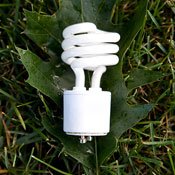It's hard to go far without hearing or seeing something about going "green." Despite jargon about carbon footprints, compact fluorescents and energy, going environmentally friendly doesn't have to be difficult. Making a few simple changes at home and monitoring utility consumption can save you money and help the environment at the same time.
Bathroom
The bathroom is one room where Americans consume lots of water and energy. Using an ultra-low-flow showerhead can save 20 to 40 percent of water while still performing like a standard showerhead. You can also modify your toilets to save water. Take an empty 2-liter soda bottle, fill it with water, screw the cap on tightly and put it in the toilet tank as far away from the flapper valve as you can. This will displace two liters or half a gallon of water every flush. Older toilets can use as much as 7 gallons per flush, so don't worry about not having enough water in the tank. If a 2-liter bottle is too large, other objects, such as a brick, will also do the job.
Electricity
To save money on your electric bill each month, make sure you turn off all lights, ceiling fans and electronic devices when you leave a room. Leaving any of them on for long periods of time, especially while away, is a waste of energy. Termed "phantom loads," "vampire power" or "leaking electricity," even when you aren't using some electronics, they are still consuming energy. DVD players, game consoles, TVs, DVRs and stereos are some of the largest culprits of phantom loads. Invest in power strips for any electronic, especially those with ready lights that use power even when idle. When finished with the electronic, turn off the power strip to avoid using excess electricity.
Heating and Cooling
The U.S. Department of Energy reports that space heating and cooling constitute 43 percent of an average American's utility bill. When leaving home, closing blinds and drapes can help reduce temperature change from windows. In the summer, closed blinds reduce the work air conditioning must do to keep your home cool. In the winter, drapes can help keep heat from escaping. Digital programmable thermostats can also help regulate heating and cooling by programming set temperatures for your needs. You can program these thermostats to change temperature while you are away and return to a comfortable temperature before you return, saving money and energy. Digital programmable thermostats are relatively inexpensive, about $30 at local home stores.
Compact Fluorescent Light Bulbs
Compact fluorescent light (CFL) bulbs, while more expensive than regular fluorescent light bulbs, save money in the long run. CFLs use about 75 percent less energy and last up to 10 times longer than an incandescent bulb. Energy savings over the lifetime of one bulb can be $30 or more on your utility bill.
The U.S. Department of Energy reports that if every American replaced one light bulb in their home with an Energy Star CFL, we would save more than $600 million in annual energy costs.


